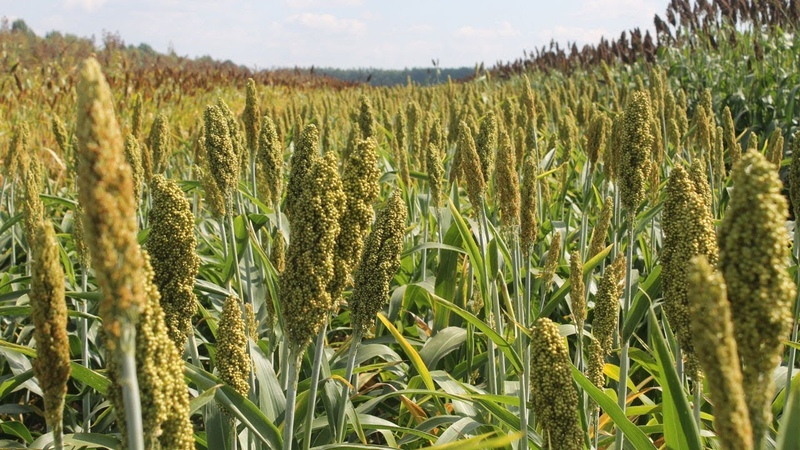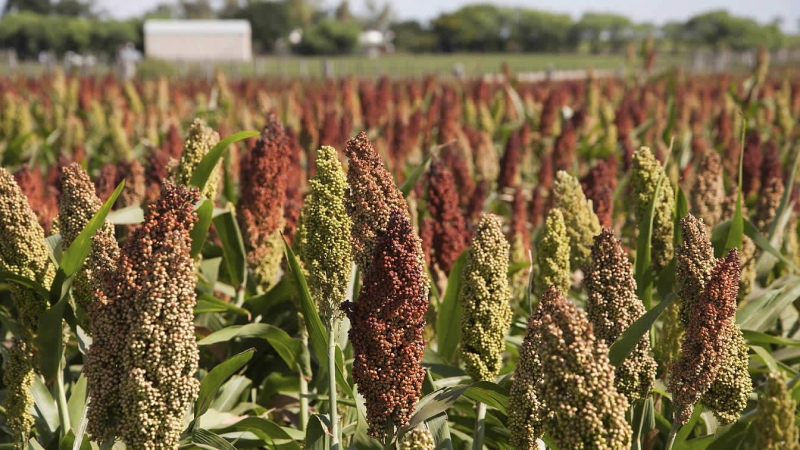Step-by-step technology for growing sorghum from seed preparation to harvest
Sorghum is a fodder, food and industrial crop with great potential. In addition to its unpretentiousness, the plant has a high yield and has a lot of useful properties, therefore it is used everywhere. The stable demand for sorghum is forcing successful and budding farmers to pay close attention to it.
The content of the article
What is sorghum
Sorghum is a multipurpose grain crop. It has a powerful root system - secondary roots appear at the time of the growth of three leaves. At the stage of 5-6 leaves, the plant gives rise to new shoots, and at 7-8, intensive stem growth begins, which slows down at the moment the panicle emerges.
The flowering period of the corolla is 7-10 days. One panicle contains one female and two male flowers. The fruit is covered with white, yellow, brown grains, small in size, milky.

When cultivating crops, leading farms receive:
- high quality grain for the preparation of feed mixtures for farm animals, including poultry and cattle;
- green mass for the preparation of pelleted feed when harvesting at the stage of milky-wax ripeness;
- to create one-year pastures, since the sugar green mass is used for harvesting silage, haylage;
- for obtaining sugar syrup with sugar content up to 15-20%;
- high quality grain to feed people with gluten intolerance;
- as a technical culture for making brooms and brushes.
When cut, the stalk of sorghum does not stop growing and grows back again - gives aftertaste. The largest amount of green mass is provided by sorghum-Sudanese hybrids and sugar varieties.
What are the features of its cultivation

It belongs to the most thermophilic and heat-resistant plants from the second group of breads, which is not surprising. Northeast Africa is considered the homeland. Today, the bulk of sorghum is produced by farmers from the arid regions of the USA, Mexico, Nigeria, and India.
The crop is recommended for cultivation by domestic farmers in the southern and south-eastern regions of Russia. High drought tolerance and undemanding to the qualitative composition of the soil makes it a universal replacement for corn, barley and other types of grain grown for silage.
On a note! Sorghum is currently grown in 85 countries of the world, on all inhabited continents.
Sorghum species

Depending on the intended economic use, four types of cultivated sorghum are distinguished:
- Broom with dry, white, rodless core, 160-270 cm high. Used for the manufacture of brooms (up to 5000 pieces per hectare). The grain is difficult to collapse, suitable for foraging.
- Herbaceous or Sudanese herb 2-2.4 m high, with strong bushiness (up to 15-16 stems per plant). The pith of the stem is semi-dry or juicy, the grain is elongated, oblong. Used to produce green pet food.
- Sugar with very juicy stems and increased bushiness, up to 3 m high. Poorly crumbling grain. It is used to obtain sugar, molasses, ethanol, biogas, green mass, silage granules, grass flour.
- Grain with low, about 80-90 cm, stems and a well-grained panicle up to 35 cm long. It is divided into yellow-seed and white-seed. The grain collapses well.Suitable for harvesting cereals, foraging, making mono feed. Leaf mass is used for setting late silage.
Each species differs in its morphological characteristics and biological properties and has its own cultivation technology. In general, the cultivation technique is similar to the millet cultivation technique.
Crop rotation rules for growing sorghum
Like any grain crop, sorghum is very demanding on its predecessors. This feature is due to the long growing season of any species. In the first 30-35 days, the seedlings of the crop are weakly competitive with respect to weeds.
As the experience of the largest exporter of sorghum, the United States, shows, the crop gives the best yields after legumes, especially soybeans, beans. For sowing sorghum, fields are also chosen after vegetable and oilseeds (mustard, cabbage, early potatoes, zucchini and others). It is not recommended to plant a crop after sunflower, Sudanese grass.
In fact, sorghum occupies the same place in the crop rotation as corn, after which all cereals grow well. The explanation for this is simple - their strong root system intensively loosens the soil and makes it possible for the grains to root freely to the desired depth.

Training
The main requirement for plots for sowing sorghum is high levels of accumulated moisture and the absence of weeds. Early spring harrowing is considered the most effective method of creating such conditions.
The main requirement for growing technology is the creation of a dense seedbed, which will ensure uniform germination.
Sowing is carried out with conditioned seeds after treatment with Baytan or Vitavax preparations at the rate of 2 kg of the preparation per ton of grain to protect against fungal and other diseases.
Landing
The best results when cultivating a crop are achieved with deep winter plowing of the area.
The number of mandatory pre-sowing measures includes soil treatment with preparations based on glyphosphate at the rate of 2 l / ha for weed control.
Sowing dates
Sorghum is a heat demanding crop. When sown in insufficiently heated soil, the seeds rot and do not germinate.
Planting is carried out when the seed layer about 5-6 cm thick warms up completely to a temperature of 12-14 ° C. Roughly - the first or second decade of May in irrigated areas, mid-late April in non-irrigated areas.
Seeding rate
The best yields are achieved when sowing to a depth of 5-7 cm and a row spacing of 50-55 cm. In such conditions, the seeding rate is 14-15 kg of grain per hectare with an expected density of 155-160 thousand plants per hectare.
Sowing instructions
Sowing includes mandatory steps:
- Simultaneous introduction of diammophoska along with planting seed. Immediately after sowing, a herbicide of the type "Primextra TZ Gold 500" is injected at a rate of 4.5 l / ha, provided that the antidote "Concept 3" is pre-sowing (according to the instructions).
- Roller packing for mulching the soil.
- Pre-emergence harrowing with medium harrows after five days to destroy 60-70% of weeds.
Further care

The biggest challenge farmers face when cultivating sorghum is weed control. Like all millet breads, sorghum is characterized by a prolonged vegetation stage and is suppressed by weeds within 4-5 weeks after the first shoots appear.
With a clear designation of the rows, inter-row cultivation is carried out to a depth of 10-12 cm, after 20-22 days - to a depth of 8-10 cm, after 45-50 days - to a depth of 6-8 cm.
Sorghum is distinguished by a high degree of responsiveness to organic and mineral fertilizers. In the spring, when sowing, 10-20 t / ha of manure is applied with a drop to the side of the seeds. Most of the mineral fertilizers are applied for fall plowing, but 10-15 kg / ha of phosphorus in the form of granular superphosphate is left to be added to the rows during sowing.
Disease and pest control
The most dangerous pest of sorghum in the Russian Federation is the cereal aphid.To combat insects, insecticides "BI-58 Novy" are used - 1 l / ha, "Nurel D" - 0.7 l / ha, "Karate Zeon" - 0.2 l / ha with a consumption rate.
Fusarium sorghum grain containing mycotoxins in large quantities is absolutely unsuitable. To prevent infection with fungi, the seed is necessarily treated before sowing with Vitavax or Baytan, and the surviving remains are destroyed in a timely manner.
Harvesting and storage

The farmer faces the greatest risks when harvesting grain sorghum during the period of sudden prolonged rains due to the risk of crumbling and rotting of the crop.
The timing of the collection of sorghum directly depends on its type and purpose:
- Sorghum is harvested for grain in September - when it reaches full ripeness by the method of direct combining at a speed of 500-600 drum revolutions per minute.
- The garnet sorghum is harvested at the end of August - at the end of the stage of the waxy ripeness of the grain, the upper part is cut off to a height of 60-65 cm and then the grain is combed out.
- Sorghum for green mass is harvested at the time of throwing the panicle, before the coarsening of the stems - from the first days of July to the end of August. On average, 2-3 mows of green mass are obtained per season with an interval of 40-45 days.
For the entire storage period of sorghum, it is important to provide constant ventilation of the grain to prevent moisture. Ventilation is carried out from the moment when the average air temperature in the hangar for three days becomes 5-8 ° C below the temperature of the grain mass.
Productivity from 1 hectare
In arid regions, the expected yield of sorghum for grain - 2.5-3.5 t / ha - is fully realized in non-irrigated conditions.
Integrated cultivation mechanization
Sowing sorghum using No-Till technology is carried out with a Boss Ag seeder with the simultaneous introduction of ammonia.
Sowing sorghum is carried out with a grain or row-crop seeder, such as "John Deere", with a working width of 3 m and an expected sowing speed of 8-9 km / h, with the cultivation of traditional technology.
After germination, harrowing is carried out only with light harrows ZBP-06 or special mesh BS-2, or wire BP-5.4, BPN-4.2, or ZBPN-4.
To eliminate the crust after heavy rains, rotary hoes ZMB-2.1, MB-2.8 or MVN-2.8 are used.
Sorghum is harvested using a grain header with a rigid cutter bar or a header for row crops.
Conclusion
With minimum costs for fertilization and soil cultivation, sorghum allows you to collect consistently high yields. The culture deserves the most attention from the farms of the Russian Federation located in hot, arid regions.
Sorghum has a wide range of uses, from use as fodder to food. This means that the demand for products will grow steadily in the coming years.